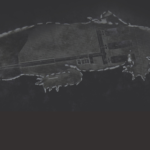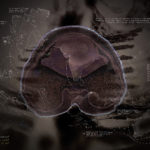The Fourth Notebook
2015 - Film & Video (Film & Video)
8:36 minutes
Sriwhana Spong
The Fourth Notebook features a solo choreography by dancer Benjamin Ord. In an empty dance studio, Ord begins seated on his knees on the floor. He moves subtly with gentle strokes to the rhythm of a woman’s voice speaking short phrases in French. His body rolls on the floor in short loop cuts and in sync with the repetition of words. Midway through, he holds various sitting, squatting and standing poses. The sounds of his feet sweeping gently against the floor and heavy breathing is exaggerated. The Fourth Notebook is inspired by the penultimate diary entry titled “To Mankind” by Polish ballet dancer and choreographer Vaslav Nijinksy (1889-1950) written in 1919 during the time his mental health was deteriorating from schizophrenia. Nijinsky, whom Spong has been fascinated with from an early age, was famous for his performances as a faun, the spirit of a rose, a puppet, a blue god and other interpretations suggesting gender and identity fluidity. Although the text is comprised of comprehensible words, it has been described as grammatically and logically untranslatable. The phonetic rhythm instead serves as the tempo to a choreography created and performed by dancer Benjamin Ord. Spong’s sharp editing also serves as an accomplice to Ord’s gestures in which quick cuts and repetition accelerate to a synesthesiastic experience where the auditory, visual and spatial elements intermingle. Spong uses Nijinsky’s last words to create a new interpretation between language and the contemporary body. Exploring the slippages between sanity and madness, past and present, language and meaning has been a consistent thread in Spong’s oeuvre.
Indonesian-New Zealand artist Sriwhana Spong’s practice invests in notions of transition, memory, translation, and the relationship between public and private space, the intuitive and the cerebral, and the body and its surroundings. With a dance background, Spong has a strong interest in choreography and meaningful dialogues and communications that different art forms can generate with each other. Her performances and videos recalls forgotten pieces and reimagines indecipherable sources by dancers she admires such as George Balanchine’s lost ballet The Song of the Nightingale and Vaslav Nijinksy’s “To Mankind” diary entry. By manipulating the sequence of gestures with the traditions and techniques of filmmaking, Spong investigates how the dance movements can register particular events in our collective memories. For Spong, the medium of film is an anthropological tool of inquiry to the search of history, its narrative, construction, transmission and alternation in time and space. Recently, Spong’s practice has shifted to language and focus on the female body, especially toward a group of women mystic writers and creators. Spong questions the ideologies motivating social norms, women’s roles and how inventing a new language is linked to freedom of speech.
Colors:
Related works sharing similar palette

© » KADIST
Drinks 6pm, Screening 7pm, Conversation 7:15pm ‘Where that which predicts its past lives working and dies fighting.’ Foregrounding a frontal approach and experiments that often push materials and technical resources to the limits of their strength, scale and movement, the works of Fabien Giraud and Raphaël Siboni challenge the ever more obvious power of machines and “modes of existence” that are taking shape separately from us human beings, sometimes without our being able to see or inhabit them...

© » ARTS EQUATOR
Migrant Ecologies Project: A Grain of Wheat Inside a Salt Water Crocodile | ArtsEquator Thinking and Talking about Arts and Culture in Southeast Asia Articles July 8, 2019 By Lucy Davis (600 words, 5-minute read) Another Chinese tradi tion, which probably has no connection with the previous one is that the Butterworth cannon belonged to ‘Pangli ma’ (Warrior) Ah Chong a bravo of the Inter-Chinese wars which took place in the Larut tin fields in 1862, and lasted sporadically for ten years...

© » KADIST
Yee I-Lann
20207-headed Lalandau Hat by Yee I-Lann is an intricately woven sculpture evoking the ceremonial headdress worn by Murut men in Borneo...

© » KADIST
Anne Imhof
2021Anne Imhof’s video work Untitled (Wave) creates resonances between the feminine, adoration, and immateriality, while also referring to the history of art and aesthetics, in particular the concept of the sublime...

© » ARTS EQUATOR
Migrant Ecologies Project: A Grain of Wheat Inside a Salt Water Crocodile | ArtsEquator Thinking and Talking about Arts and Culture in Southeast Asia Grain of Wheat July 8, 2019 Wheat Grain World Dreams , the centre section from the artist’s book contains a map that includes some of our research questions around, for example, histories of 19th century cash crops and the crimes of the British India Company; and the extension of China’s Belt and Road journey West...

© » SLASH PARIS
Mathilde Lestiboudois — Le Matin des souffles — Les églises centre d'art de Chelles — Exposition — Slash Paris Connexion Newsletter Twitter Facebook Mathilde Lestiboudois — Le Matin des souffles — Les églises centre d'art de Chelles — Exposition — Slash Paris Français English Accueil Événements Artistes Lieux Magazine Vidéos Retour Mathilde Lestiboudois — Le Matin des souffles Exposition Peinture Mathilde Lestiboudois, Bassins et drapés, 2022 160 × 200 cm Courtesy de l’artiste — BD Mathilde Lestiboudois Le Matin des souffles Encore environ un mois : 12 novembre 2023 → 21 janvier 2024 Pour son exposition au Centre d’art, Mathilde Lestiboudois conçoit une œuvre qui établit un dialogue avec l’architecture du lieu d’exposition...

© » ARTS EQUATOR
Quiz: What's Your Guilty Pleasure? | ArtsEquator Thinking and Talking about Arts and Culture in Southeast Asia ArtsEquator Viewpoints Kristina Flour via Unsplash November 11, 2021 It’s 2021 – and you’re constantly being told to be your best self! There’s that pile of books waiting to be read, countless browser tabs open with must-read articles, and a list of podcasts that are supposed to make you smarter...

© » ARTNEWS
Michael Stipe on His Collection Exhibition at the Outsider Art Fair – ARTnews.com Skip to main content By Andy Battaglia Plus Icon Andy Battaglia Deputy Editor, ARTnews View All March 2, 2022 11:49am View Gallery 10 Images When Michael Stipe first started engaging with outsider art, he was a young buck learning the curious folkways of Athens, Georgia, while on the cusp of fronting the storied rock band R...

© » KADIST
Tanatchai Bandasak
2019Central Region by Tanatchai Bandasak is a meditation on materiality and time-based media centres on the mysterious, prehistoric ‘standing stones’ of Hintang in Northern Laos: little-studied megaliths which have survived thousands of years of political change and the cataclysmic carpet-bombing of Laos by the United States during the Cold War...

© » KADIST
Karan Shrestha
2017After the decade-long conflict (1996-2006) that ended with Nepal becoming a Federal Democratic Republic, political unrest and weak governance continued to mark the country’s future as daily life repeatedly witnessed ruptures...

© » KADIST
Leslie Shows
Human Quarry is a large work on paper by Leslie Shows made of a combination of acrylic paint and collage...

© » SLASH PARIS
Gildas Le Reste — & Guests — Galerie Catherine Putman — Exposition — Slash Paris Connexion Newsletter Twitter Facebook Gildas Le Reste — & Guests — Galerie Catherine Putman — Exposition — Slash Paris Français English Accueil Événements Artistes Lieux Magazine Vidéos Retour Précédent Suivant Gildas Le Reste — & Guests Exposition Dessin, estampe, peinture Gildas Le Reste, Notes de voyage #1, 2023 Encre sur papier marouflé sur toile Gildas Le Reste & Guests Encore 27 jours : 27 janvier → 9 mars 2024 La galerie Catherine Putman est heureuse de proposer une double invitation à Gildas Le Reste, comme artiste et commissaire d’exposition...

© » KADIST
Shi Guowei
Through a hand-painting process, Shi Guowei created Manufactured Landscape ...







